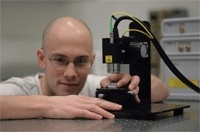Spotting the signs
Improving resolution of systems used to image human tissue could help early identification of life-threatening diseases.

Researchers at the National Physical Laboratory (NPL) have developed a new means to ensure that a screening technique using Optical Coherence Tomography (OCT) systems can be relied upon by clinicians so that they can accurately spot early signs of cancer.
OCT is an increasingly popular method for looking beneath the surface of certain materials, notably human tissue. Although it can only be used to image tissue at depths of a few millimetres, it can produce higher-resolution images than either MRI or ultrasound, making it suitable for detecting changes in tissue structure that can indicate the early stages of cancer.
Indeed, OCT systems such as those from Orpington Kent-based Michelson Diagnostics have already proven capable of imaging microstructures in living tissue in real time at depths of 1mm or more at a resolution of less than 10µm.
In a simple OCT system, a source of light from a laser is separated into two beams by a Michelson interferometer — one beam is focused on a sample through a lens and the other half is directed towards a reference mirror. The light reflected from the mirror and from the sample is then sent to a detector that measures the degree of interference between the two sources. The signal from the detector is then processed and used to create a spatial reflectivity map of the sample that contains both depth and intensity information.
Register now to continue reading
Thanks for visiting The Engineer. You’ve now reached your monthly limit of premium content. Register for free to unlock unlimited access to all of our premium content, as well as the latest technology news, industry opinion and special reports.
Benefits of registering
-
In-depth insights and coverage of key emerging trends
-
Unrestricted access to special reports throughout the year
-
Daily technology news delivered straight to your inbox










CCC Report Finds UK Climate Targets Still Within Reach
In 1990 67% of the UK´s electricity came from coal-fired power stations and even without renewables the transition to gas was a major contributor to...